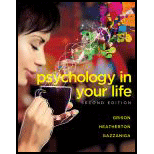
To determine:
How might children’s observations influence their beliefs and lead to the creation of stereotypes? How might these stereotypes impact their behaviors later in life?
Concept introduction:
By grouping information into cognitive schemas, the brain is able to quickly process information about a person or a thing. This information can be used to make decisions, take certain actions, or judge a person or situation in a particular way, often without much thought. Making these assumptions, or generalizations, is called stereotyping. Stereotypes can be helpful when the brain needs to quickly process information. But, they can also be harmful if they cause people to behave in unfair ways, such as sexism or racism.
Explanation of Solution
Suggested responses:
Children’s minds are still developing and they are still learning about the world. Much of their learning comes from observing the people in their environment and then modeling, or imitating, the behaviors they see. By observing parents and other adults (such as actors in TV shows, commercials, and movies), children can learn to define certain behaviors as “adult behaviors.” If children see their parents smoke or drink a beer every night after work, they can come to develop a schema—or make an assumption—that this is normal behavior for adults, especially adults they look up to and respect.
The preschool children in the experiment “bought” cigarettes and alcohol even though they had never used these things because they believed that this is what adults would buy at the supermarket. The results showed that children were more likely to “buy” cigarettes and/or alcohol if they lived in a home where use of these items was common because they had developed assumptions, or stereotypes, about drinking and smoking through their observations of the adults in their lives.
If children grow up with this kind of stereotype, or belief, consider how it could impact their behavior and beliefs when they grow up. If a child’s assumption is that smoking is normal, or even “cool,” they may see no problem with picking up smoking when they get older. If children see beer and wine at all their family parties, they may assume that any party should have these drinks, which could lead them to want alcohol for their high school party, even though they are underage. These are just a few examples of how a person’s observations and beliefs in childhood could impact their own behaviors in adulthood. It is also a good example of how important it is for children to have good role models from whom to learn good behaviors.
Want to see more full solutions like this?
Chapter 8 Solutions
Psychology in Your Life (Second Edition)
- Describe behaviourism and cognitive psychological perspectives.arrow_forwardEvaluate the key assumptions of behaviourism and cognitive psychological perspectives.arrow_forwardable to help me with this for revision purposes and used reference in APA Required reading: • McKevitt, G. (2024, September 2). https://www.bbc.com/culture/article/20240829-the-life-changing-day-world-war-two-beganarrow_forward
- What strategies and techniques can social workers use to inform and influence organizational and social policy? What are advantages and disadvantages of various policy change strategies and techniques? Please cite in text source and list references.arrow_forwardWhat are three professional best practices that school counselors can implement or can recommend in schools after watching the YouTube video titled “The Effective School Counselor with a High-Risk Teen: Motivation Interviewing Demonstration” (https://www.youtube.com/watch?v=_TwVa4utpII) by MerloLab (MerloLab, 2015)? Please write in a narrative format and include citations.arrow_forwardWhat are three strategies school counselors use in schools after watching the YouTube video titled: “The Effective School Counselor with a High-Risk Teen: Motivation Interviewing Demonstration” (https://www.youtube.com/watch?v=_TwVa4utpII) by MerloLab (MerloLab, 2015)? Please write in a narrative format and include citations.arrow_forward
- What are three interventions or programs school counselors can implement in schools after watching the YouTube video titled “The Effective School Counselor with a High-Risk Teen: Motivation Interviewing Demonstration” (https://www.youtube.com/watch?v=_TwVa4utpII) by MerloLab (MerloLab, 2015)? Please write in a narrative format and include citations.arrow_forwardWhat are three methods for dissemination of information that school counselors can use after watching the YouTube video titled “The Effective School Counselor with a High-Risk Teen: Motivation Interviewing Demonstration” (https://www.youtube.com/watch?v=_TwVa4utpII) by MerloLab (MerloLab, 2015)? Please write in a narrative format and include citations.arrow_forwardWhat are the three most important knowledge a school counselor can gain from watching the YouTube video titled: “The Effective School Counselor with a High-Risk Teen: Motivation Interviewing Demonstration” (https://www.youtube.com/watch?v=_TwVa4utpII) by MerloLab (MerloLab, 2015)? Please write in a narrative format and include citations.arrow_forward
 Ciccarelli: Psychology_5 (5th Edition)PsychologyISBN:9780134477961Author:Saundra K. Ciccarelli, J. Noland WhitePublisher:PEARSON
Ciccarelli: Psychology_5 (5th Edition)PsychologyISBN:9780134477961Author:Saundra K. Ciccarelli, J. Noland WhitePublisher:PEARSON Cognitive PsychologyPsychologyISBN:9781337408271Author:Goldstein, E. Bruce.Publisher:Cengage Learning,
Cognitive PsychologyPsychologyISBN:9781337408271Author:Goldstein, E. Bruce.Publisher:Cengage Learning, Introduction to Psychology: Gateways to Mind and ...PsychologyISBN:9781337565691Author:Dennis Coon, John O. Mitterer, Tanya S. MartiniPublisher:Cengage Learning
Introduction to Psychology: Gateways to Mind and ...PsychologyISBN:9781337565691Author:Dennis Coon, John O. Mitterer, Tanya S. MartiniPublisher:Cengage Learning Psychology in Your Life (Second Edition)PsychologyISBN:9780393265156Author:Sarah Grison, Michael GazzanigaPublisher:W. W. Norton & Company
Psychology in Your Life (Second Edition)PsychologyISBN:9780393265156Author:Sarah Grison, Michael GazzanigaPublisher:W. W. Norton & Company Cognitive Psychology: Connecting Mind, Research a...PsychologyISBN:9781285763880Author:E. Bruce GoldsteinPublisher:Cengage Learning
Cognitive Psychology: Connecting Mind, Research a...PsychologyISBN:9781285763880Author:E. Bruce GoldsteinPublisher:Cengage Learning Theories of Personality (MindTap Course List)PsychologyISBN:9781305652958Author:Duane P. Schultz, Sydney Ellen SchultzPublisher:Cengage Learning
Theories of Personality (MindTap Course List)PsychologyISBN:9781305652958Author:Duane P. Schultz, Sydney Ellen SchultzPublisher:Cengage Learning





